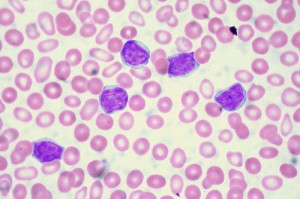 Leukemia is an abnormal production of blood cells, usually white blood cells (GB). In short, the bad cells crowd out healthy cells in the blood and and after some time normal blood cells die and are replaced by new cells produced in bone marrow. Abnormal blood cells do not die so easily, and accumulate, holding space. As increasingly more space occupied by the defective cells there is less room and less like normal cells – and the victim falls more and more ill. This anomaly causes blood cells to grow and divide chaotically.
Leukemia is an abnormal production of blood cells, usually white blood cells (GB). In short, the bad cells crowd out healthy cells in the blood and and after some time normal blood cells die and are replaced by new cells produced in bone marrow. Abnormal blood cells do not die so easily, and accumulate, holding space. As increasingly more space occupied by the defective cells there is less room and less like normal cells – and the victim falls more and more ill. This anomaly causes blood cells to grow and divide chaotically.
Experts acute and chronic leukemia in four groups, each one can be acute, which is a rapidly progressing disease that results from the accumulation of immature cells, unnecessary bone and blood, or chronic, which progresses more slowly and allows more mature cells useful for made. In other words, the multitudes of acute leukemia cells faster than cancer occur in chronic leukemia. A lymphocyte is a type of white blood cells in their immune system. Lymphocytic vertebrae and myeloid leukemia are divided into two types. If malignant transformation occurs in the type of marrow cell.
Blood clotting is poor – How immature white blood cells to replace blood platelets, which are necessary for blood clotting, the patient may bruise or bleed easily and heal slowly – you may also develop petechiae (red purple small spot to live, caused by a small hemorrhage). The patient may experience recurrent infections or the immune system may attack the immune system to other organ cells. Anemia – As the shortage of good red blood cells, increasing the patient may suffer from anemia – This can cause difficulty breathing or wheezing (breathing) and pallor (pale skin color caused by the disease).
Precaution – As all of these symptoms may be due to other illnesses. Headache is more common in patients whose cancer cells have invaded the CNS (central nervous system).
Type of treatment depends on the patient’s age and his health. Because the treatment is improved, the goal of almost all health care providers should complete remission – which the cancer goes away completely for at least five years treatment. As leukemia affect different patients differently, the treatments depends on the type of which have. In get the most effective treatment, patients should receive treatment center, where doctors are experienced and are well trained in the treatment of patients with leukemia.
Doctors sometimes drug test bone as marrow. He probably Glivec (imatinib mesylate), which inhibits the BCR-ABL cancer gene. Those who do not usually treated with chemotherapy or monoclonal antibody therapy. This blood tests and may be associated with chemotherapy and bone marrow transplantation (allergenic stem cell). Patients were not usually given the success of Gleevec and Sprycel Tarigna. When a patient is in remission, it will still need a consolidation therapy or following induction therapy. There other drugs Sprycel (dasatinib) and Tarigna (nilotinb), which also block the BCR-ABL cancer gene. As time passes, and patient continues to remain free of leukemia, the doctor may decide to extend the intervals between tests. If a patient has chronic myelogenous leukemia (CML), treatment should begin as soon as the diagnosis is confirmed. All leukemia patients, regardless of the type they have or have had will be regularly monitored by their doctor after the cancer is gone (in remission).
No Comments Yet